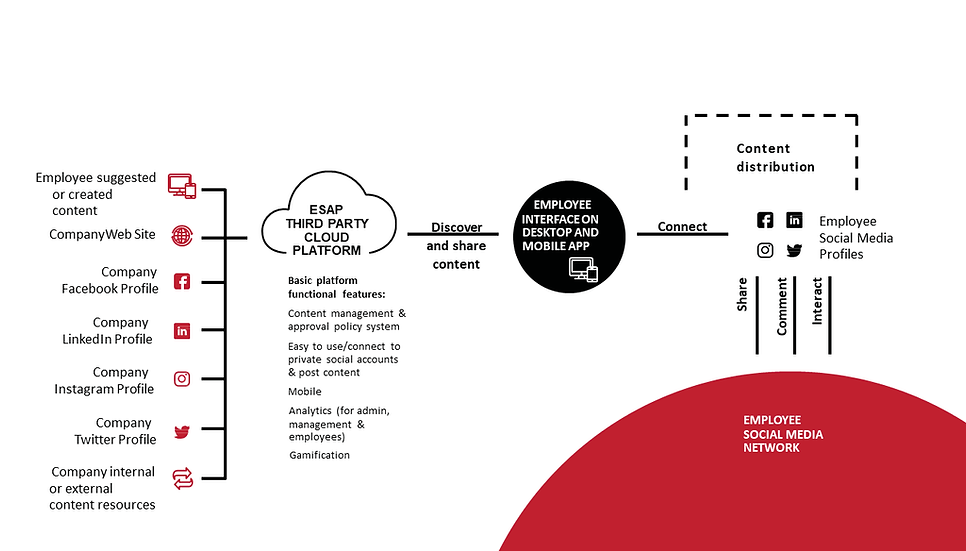
Platform integration.
The technology platform is easy to integrate into the organization's existing IT environment and requires no intervention in the IT infrastructure. On the one hand, it connects the organization's existing resources that are important for creating or accessing content (internal tools, official communication channels of the organization - website, portals, profiles on social networks, etc.) with salespeople, who in this way have easy and transparent access to all the organization's content that is suitable for social selling activities. The salespeople then connect to the platform using their private social network profiles.
In this way, connected sales reps get an effective tool for sharing content that can be shared across multiple social networks with one click, optimizing time and effectiveness of communication. The platform supports the ability to edit content, monitor the effectiveness of shared content, and personification. It is a simple but effective tool for managing content on digital channels, intended for further sharing by sales representatives involved in the Social Selling program.
The technology platform also enables salesperson-led analysis of platform usage, measurement of response to content shared on social networks, and enables tracking of inbound traffic and leads generated by the program.
You might be also interested

What is Social Selling?
Business markets have witnessed major changes in customers’ buying behavior due to the recent digitalization trend. Customers are becoming more informed and less reliant on traditional selling initiatives. Recent research has indicated that more than three quarters of all buyers have very limited interaction with salespeople. This is an issue not only for simple offerings but also for complex solutions and value-based sales in which salespeople frequently struggle to engage customers early enough.
Empowered buyers are also increasingly relying on digital resources and their buying processes or ‘purchasing journeys’ increasingly involve the use of social media. In fact, in a recent B2B buyer survey, 82% of the buyers noted that social content has an impact on their buying decisions. These changes place significant pressure on B2B salespeople and traditional sales organizations.
Practitioners and academics alike have started to discuss social selling as a prominent contemporary selling approach with considerable potential in the B2B sales domain.
Social selling is defined as a professional selling approach predicated on the strength of social media allies within a social enterprise/social business, emphasizing salespeople’s use of social interaction-enhancing platforms for content-creation and networking. With regard to practitioners, assert that social selling is the strategy of including social media in the salesperson’s toolbox for the purposes of researching, prospecting, networking, and building relationships by sharing content and answering.
Tentative evidence from industry leading firms such as Adobe, IBM, Dell, Microsoft, Vodafone, Roche, BNP Paribas, Alliance, Allianz and Maersk, as well as from consultancy reports, indicates that social media and digital channels can be used in sales to facilitate effective dialogue with buyers, even in industries that are not usually considered to be ‘social’. Academic research has further found that social media usage in sales is positively related to salespeople’s customer knowledge, sales behaviors and selling performance.

Social Selling
Individual aspects of Social Selling
Social selling is a selling process, which leverages social and digital channels for understanding, getting in touch with, and engaging influencers, prospects and existing customers at relevant customer purchasing journey touchpoints for developing valuable business relationships.
The construct has 3 core elements:
-
Obtaining insights into prospects, existing clients, and influencers through social and digital channels
-
Connecting to relevant actors through networking and constant dialogue at relevant touchpoints
-
Engaging actors through beneficial content in order to influence their tendencies to invest resources in their interactions with the seller and other relevant actors. In other words, it focuses on creating commonalities between the seller and the empowered, social buyer early in the buying process in touchpoints that are pertinent for the customer
The success of the approach is likely to be contingent on the simultaneous use of client oriented selling approaches, such as consultative or value-based selling that substantiate the capacities raised by social selling. While the process can help salespeople to link to buyers in the early stages of buying, build trust, or be seen as useful advisors, salespeople need to strengthen its possibilities through concrete client oriented selling behaviors.
A central tenet of social selling is being active at the correct time and in the right place during customers' purchasing journeys so that established "connections" in social and digital channels can be moved into "real world sales" utilizing traditional selling processes. This requires a long-term pull approach, established on the engagement of customer stakeholders and other relevant actors often without any immediate or apparent direct sales implications.
The concepts imply that the domain of social selling construct surpasses the mere use of social media in sales. We argue that social selling is much better understood as a selling approach which focuses on implementing digital marketing principles, consisting of content marketing and social media marketing at the individual salesperson level.
Three Core elements of Social Selling
Acquisition of deep customer insights in Social Selling
First central element of social selling is the acquisition of insights into prospects, existing customers and influencers through social and digital channels. This activity requires the salesperson to collect client purchasing associated information in order to efficiently guide the sales process and satisfy the customers' needs in an appropriate and timely way.
Salespeople can leverage social media to recognize business and people that fit the targeted "perfect" client profiles, for enhanced lead qualification and for efficiently steering the sales process. This involves screening potential customers' social media profiles and actively "listening" to customers and rivals.
Sellers can utilize social media to collect relevant information about the potential customer's key stakeholders, such as common connections, interests, and experiences. Information can likewise be used to develop an understanding of the potential customer's buying process and buying center structure, consisting of the decision makers and other important actors within and outside the customer's organization.
Additionally, the acquisition of customer insights in social selling can assist in understanding the requirements of prospects
and clients. Notably, the timing aspect is strongly present, because strategically "listening" to clients' conversations on social media allows salespeople to establish a greater understanding of the customers' specific scenarios and current business requirements in a non-intrusive way. An accurate understanding of customers' specific needs is ending up being significantly relevant for approaching, efficiently and non-intrusively, the increasingly informed and powerful buyers through carefully targeted efforts.
Connecting to relevant actors in Social Selling
The next recognized facet of social selling is the salesperson's efforts to connect to influencers, prospects, and existing buyers through networking and consistent dialogue at relevant client purchasing journey touchpoints.
This aspect consists of efforts to develop relational networks by developing professional connections with prospective and existing customers, and by fostering systematic dialogue with these connections in social and digital channels. Hence, social selling leverages the fundamental ground of social media; that is, the ability to create and preserve a network of personal contacts through digital and social channels.
We wish to stress the importance of consistent dialogue with influencers, potential customers, and existing customers through commenting, questioning, or answering relevant questions.
Instead of one-way interaction, social selling has the potential to facilitate dialogue in between salespeople and pertinent actors. Social media channels represent a critical platform for prompt interaction with clients and other influential actors.
Engaging through valuable content in Social Selling
Whilst the second connecting-facet of social selling concentrates on building consistent dialogue with possible and existing connections in the relevant touch-points and at the right time, the third engagement-related aspect relates to the nature of the dialogue.
This third aspect of social selling concerns engaging customers and other appropriate actors through valuable content, hence for influencing their dispositions to invest resources in their interactions with the seller and other appropriate actors social selling is not about sales-focused interaction with a target audience but about engaging pertinent actors with content that fits their interests, goals, and problems beyond the selling task. These efforts can assist to develop common ground for a future relationship by affecting the relevant crucial actors' engagement.
Effective engagement depends upon the importance and value of the content that salespeople supply.
Instead of focusing on the company's products or services, salespeople must focus on providing business-problem-focused content to draw in the attention of informed and empowered customers in addition to other influential crucial actors.
While using Social Selling the significance of illustrative and trusted content such as white papers, recommendations, and
trusted external sources are crucial. This aspect is at the same time highly consistent with current studies on content marketing, which highlight the value of delivering relevant, compelling, and timely content based on buyer needs.
The anticipated results of Social Selling
Personal Brand
Primary outcome is advancement of a strong personal brand as one of the key results of social selling. Specifically, systematic social selling activities have the potential to develop a thought leadership position with the target customers. Personal brand has more comprehensive role in supporting buyers spontaneously connecting to the salesperson in respect of buying related issues.
Selling Performance
We can expect to enhance 3 main performance areas, particularly:
-
lead generation,
-
sales process performance,
-
revenues.
Social selling has a specific effect on the front end of the selling cycle, by assisting salespeople to produce an increased number of better-quality leads, along with obtaining greater closing ratios and shorter sales cycles during the sales process.
In contrast to many traditional approaches, social selling represents an effective method of approaching attractive leads and potential customers in a non-invasive and more personal approach. These front-end results need to have an effect on a salesperson's sales performance in the long term.
Buyer Satisfaction
At the salesperson level, social selling principle has following key activities:
-
acquisition of deep insights into prospective and existing buyers,
-
linking to customers and other influential actors at pertinent touch-points through networking and dialogue
-
engaging pertinent actors through valuable content.
The approach is not simply another sales channel for making sales pitches however a way to engage the educated, empowered, and social buyers during their purchasing journeys utilizing digital and social channels. The approach requires high customer focus and simultaneous use of client oriented selling activities such as consultative and value-based selling.
On the other hand a narrow view of social selling is likely to cause customers to see the efforts as "spam" or "lip-service" engagement without genuine substance.
The organizational aspects of Social Selling
Social selling is an individual salesperson level concept but organizations play a vital role in its effective company-wide execution.
At the organizational level, social selling offers a strategic possibility for firms to deal with the changed buying behavior in B2B markets. An organizational social selling strategy ought to include social media policies for sales, buying behavior-based segmentation and targeting, the integration of social selling into the selling process, social selling goals and metrics, organizational alignment, content development and sharing, and provision of technological sales tools.
For this purpose, organizations need a Social Selling Strategy.
There are two groups of strategy elements:
1. General management components:
-
General management support
-
Top executives must demonstrate to their teams that they believe in social. Change takes dedicated, active, and inspired leadership. It is equally important that prominent sales members take ownership of the process by promoting social selling across the company and guaranteeing that managers incorporated social selling KPIs in their evaluation process.
-
-
Change management
-
The journey from traditional sales techniques to social selling certainly needs that you think about the motivation, costs and benefits, however the human component equally requires to be addressed. Moving to a social selling model successfully counts on organizational change, specifically organizational change which is in tune with the shift in customer behavior. In particular, embracing social selling on an organization-wide basis is no small task; it involves moving the culture of sales and marketing teams, to name a few things. Convincing your team to go social needs more than just information, white papers, and research studies showing that adopting social selling is worth the effort.
-
-
Training
-
When salespeople are provided the training and support, they require to use social selling techniques successfully, they'll reap all of these advantages for business. Providing possibilities to boost their knowledge, refine their techniques, and find out new approaches for engaging audiences old and new can only pay off in the form of a rising ROI for the social selling strategy.
-
2. Social Selling elements:
-
Social Media Policy
-
It is very important to accurately define and discuss a social media policy for social selling in order to achieve the very best outcomes. Businesses should recognize the right people to handle social media tools, allowing employees to use social media and providing standards for its proper usage.
-
-
Buying behavior-based segmentation and targeting
-
Companies ought to support their salespeople in understanding who the perfect target buyers are, what kinds of channels they use, what their typical organizational requirements are, which stakeholders are typically involved in buying, and what issues individual buyers have. Comprehensive buyer profiles can help in lead qualification and guiding the social selling efforts.
-
-
Social Selling Integration
-
An organizational social selling strategy should systematically incorporate social selling activities into selling processes.
-
-
Goals and metrics
-
Social selling strategy must equally consider particular objectives and metrics. Sometimes it is hard to identify the direct short-term results of social selling activities, so managers ought to focus on long-term organizational goal setting. Executives ought to carefully adapt the KPIs and metrics, taking into account the nature and purpose of social selling activities. They specify activity-focused metrics for evaluating salespeople's performance, such as the quantity of leads, shared content, quantity of face-to-face interactions, or demonstrations attained through social selling practices, among others. The procedures need to not merely focus on the amount but at the same time deal with the quality of the activities to get the very best outcomes.
-
-
Organization alignment
-
Organizational alignment is a critical component in social selling strategy. Sales and marketing, especially, ought to work together with distinct functions for effective management of online and offline conversations with potential customers and buyers. Social selling requires accurately defined functions and clear responsibilities for getting involved departments, in some cases involving non-sales parties in the organization. One primary area of practical collaboration concerns the organizational creation and sharing of content. Social selling efforts gain from wide social media advocacy among employees and organizations need to understand how to inspire non-sales people to become active in social content sharing. In this regard, marketing function should have versatile and encouraging, instead of a predominant approach to assist salespeople to engage customers with content.
-
-
Tools
-
Organizations need to carefully consider the provision of technological tools for supporting their salespeople's social selling efforts. Accurately, businesses are increasingly utilizing digital marketing- and sales-related innovations.
-
Summary
The understanding of clients' buying process, continued meaningful conversations, and the supply of valuable insights help salespeople to build trust in the relationships.
In doing so, social selling can also affect buyer satisfaction. Furthermore, social selling is most likely to facilitate customer recommendations through engagement and sellers' personal branding.
A systematic application of social selling among salespeople may also affect a company's performance in the long-term through the combined results of salesperson-and customer-related outcomes in two essential areas specifically brand awareness and organizational selling performance.
We can help you with all aspects of implementing Social Selling. Need peace of mind and the benefit of experience.
Learn more here.











